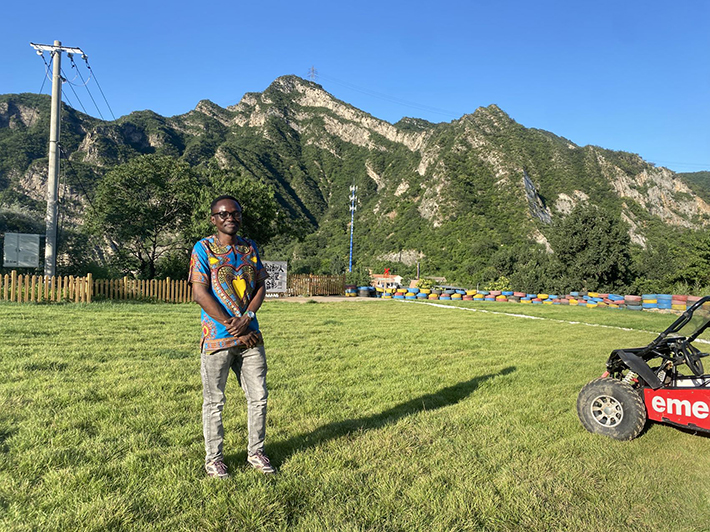|
||||||||||
| Home Top News Economy/Tech Culture/Sports China in Foreign Eyes Green Development Videos Intangible Cultural Heritages |
|
||||||||||
| Home Top News Economy/Tech Culture/Sports China in Foreign Eyes Green Development Videos Intangible Cultural Heritages |
| ChinAfrica |
| Resilience and Rebirth |
| Mentougou’s recovery serves as a model for rebuilding after a natural disaster |
| By Adibase Raphael | VOL. 17 November 2025 ·2025-11-05 |

Adibase Raphael during a visit to Mentougou in Beijing (COURTESY)
Located on the mountainous western edge of Beijing Municipality, Mentougou District is renowned for its breathtaking natural landscapes and rich cultural heritage. On 22 June, I had the opportunity to visit the district, nearly two years after it was struck by a catastrophic flood that left widespread destruction in its wake. My visit provided a unique opportunity to observe the ongoing recovery efforts and evaluate how the district has leveraged coordinated planning, technology and the resilience of its people to rebuild. The purpose of the visit was to witness these recovery efforts firsthand and gain insight into the strategies that have helped Mentougou overcome the lingering effects of this environmental disaster.
The experience was both intellectually enriching and emotionally profound. From attending a moving musical concert celebrating the community’s recovery, to exploring the historically significant Ma Zhiyuan residence and participating in a tea tasting at Mr. Lu’s traditional tea shop, each encounter deepened my appreciation for the district’s collective resilience. Visits to local museums and a revitalised mountain farm - home to a diverse mix of domesticated and wild species - showcased how Mentougou has seamlessly integrated ecological awareness into its long-term recovery strategy. The district’s transformation is no longer merely a story of loss; it has become a powerful case study in environmental adaptation and urban resilience.
The flood disaster and local response
The flooding that struck Mentougou District between 29 July and 2 August 2023 was one of the most severe natural disasters in Beijing’s recorded history. Triggered by the remnants of Typhoon Doksuri, the storm unleashed over 740 millimetres of rainfall, nearly equivalent to the district’s entire annual average, within just a few days. The sheer volume and intensity of the rainfall overwhelmed river systems, triggered landslides in the mountainous regions, and led to the collapse of vital infrastructure across the district.
The government’s response to the disaster was swift and multifaceted. Emergency rescue teams, including the People’s Liberation Army, were quickly deployed to evacuate stranded residents, deliver essential supplies and restore access to critical services. Helicopters and amphibious vehicles were used to reach remote communities. Temporary shelters were set up in safer zones, with medical teams mobilised to prevent outbreaks of disease.
In the aftermath of the immediate emergency phase, the municipal and district governments launched an ambitious recovery and reconstruction programme. A cornerstone of this strategy was the integration of flood-resilient infrastructure. Riverbanks were reinforced, roadways were elevated and a district-wide drainage overhaul was implemented using sponge city principles, a Chinese innovation that allows urban areas to absorb and naturally filter stormwater through green infrastructure.
Advanced early warning systems were introduced, utilising artificial intelligence, meteorological sensors and satellite data to predict extreme weather events. These systems were integrated into community communication networks, allowing real-time alerts to be sent to mobile devices. Public education campaigns were also launched to enhance community preparedness and response capabilities.
Environmental sustainability became a central pillar of the recovery strategy. Hillsides vulnerable to landslides were reforested, wetlands were restored to serve as natural flood buffers, and construction was permanently banned in high-risk floodplains. This ecological approach not only mitigated future risks but also revitalised the natural beauty and biodiversity for which the district was once celebrated. The mountain farm I visited stood as a model of this transformation, where sustainable agriculture and wildlife protection now coexist with the livelihoods of local communities.
Implications for Ghana
Mentougou’s experience offers valuable lessons for countries such as Ghana, where annual floods in cities like Accra, Tamale and Wa continue to displace thousands and devastate livelihoods. Much like the conditions that preceded the 2023 flood in Mentougou, Ghana’s vulnerability to flooding is driven by poor urban planning, unregulated construction, deforestation and increasingly erratic rainfall patterns exacerbated by climate change.
One of the most important lessons is the need for integrated and anticipatory urban planning. Ghanaian cities must invest in resilient infrastructure capable of withstanding extreme weather events. This includes building elevated roads, reinforcing stormwater drainage networks and adopting sponge-city concepts adapted to local hydrological conditions. Furthermore, disaster preparedness must extend beyond infrastructure to include community-based early warning systems and regular simulation drills for populations in flood-prone areas.
The Mentougou model also highlights the critical role of ecological restoration. Ghana, which has experienced significant deforestation in its northern and central regions, could benefit from robust reforestation initiatives and the protection of wetlands in flood-prone areas such as the Odaw Basin in Accra and the White Volta floodplain in the north. These ecosystems can act as natural buffers, absorbing excess water during periods of heavy rainfall.
Moreover, Mentougou’s reconstruction demonstrates how disasters can be transformed into opportunities when governance is decisive and inclusive. Ghanaian authorities must enforce building codes, remove illegal structures from waterways and commit to long-term flood risk mapping and zoning. Implementing such measures will require political will, public engagement and sustained investment, areas where international collaboration can play a pivotal role.
In conclusion, my visit to Mentougou District was more than an observational tour - it was a journey through a narrative of loss, resilience and renewal. Just two years ago, the region lay submerged under a natural disaster that destroyed homes, lives and landscapes. Today, it stands as a testament to what is possible when recovery is guided by foresight, science and community-centred planning.
The author is M.A. Student from China Agricultural University
|
||
| About Us | Contact Us | Advertise with Us | Subscribe |
| Copyright Beijing Review All rights reserved 京ICP备08005356号-5 京公网安备110102005860号 |